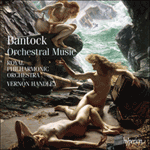At its first performance, in London’s Queen’s Hall on 21 February 1920,
The Sea Reivers was described as a ‘Hebridean Sea-Poem’. Though Sir Henry Wood was the concert’s principal conductor (the programme included the first performance of Delius’s Concerto for violin and cello), Bantock took charge of his own work. Composed in 1917, it is a concise, vigorous scherzo based on ‘A Hebridean Sea-Reiver’s Song’ (
Na Reubairean). This had also appeared in the Kennedy-Fraser collection, and expresses the wild exultation and daring exploits of the Hebridean pirates. At first only hinted at, the song soon appears in its entirety in tumultuous and vivid orchestral colours. According to ‘Grove V’,
The Sea Reivers was originally intended as the scherzo section of the
Hebridean Symphony. Although no mention is made of this in the composer’s programme notes for the first performance, it would seem very likely as the work is unusually brief for Bantock.
from notes by Michael Hurd © 1991
Lors de sa première représentation, dans le Queen’s Hall, le 21 février 1920,
The Sea Reivers furent décrits comme un «poème marin des Hébrides». Bien que Sir Henry Wood ait été le principal chef d’orchestre de ce concert (le programme comprenait la première représentation du Concerto pour violon et violoncelle de Delius), Bantock dirigea son œuvre. Composée en 1917, c’est un scherzo concis et vigoureux dont la base est «A Hebridean Sea-Reiver’s Song» (
Na Reubairean). Cette chanson était aussi apparue dans la collection de Marjory Kennedy-Fraser et exprime la sauvage exultation et les exploits audacieux des pirates des Hébrides. Bien qu’au début il n’y ait qu’une vague allusion à la chanson, elle ne tarde pas à apparaitre en entier en couleurs tumultueuses et brillantes. Si l’on en croit «Grove V» (encyclopédie anglaise)
The Sea Reivers était à l’origine destiné à être la section scherzo de la
Hebridean Symphony. Bien qu’aucune mention n’en soit faite dans les notes du compositeur pour la première représentation, cela semble très probable car l’ouvrage est inhabituellement bref pour Bantock.
extrait des notes rédigées par Michael Hurd © 1991
Français: Alain Midoux
Bei seiner Uraufführung am 21. Februar 1920 in der Queen’s Hall wurde
The Sea Reivers als „Meerespoem von den Hebriden“ beschrieben. Obwohl Sir Henry Wood leitender Dirigent des fraglichen Konzerts war (das Programm umfasste unter anderem die Uraufführung von Delius’ Konzert für Violine und Cello), dirigierte Bantock selbst seine Komposition. Sie entstand 1917 und ist ein markantes, kraftvolles Scherzo, das auf einem „Seeräuberlied von den Hebriden“ (
Na Reubairean) beruht. Dieses Lied war ebenfalls in der Sammlung Kennedy-Fraser erschienen und geht auf die wilde Fröhlichkeit und die gewagten Beutezüge der Piraten ein. Nachdem es zunächst nur angedeutet wurde, wird das Lied mit turbulenten, lebhaften Orchesterklangfarben in ganzer Länge vorgetragen. Im 5. Band von
Grove’s Dictionary of Music and Musicians ist zu lesen, dass
The Sea Reivers ursprünglich als Scherzo der
Hebridean Symphony vorgesehen war. Obwohl davon in den Programmnotizen des Komponisten zur Uraufführung nicht die Rede ist, erscheint diese Annahme durchaus gerechtfertigt, da das Werk für Bantock ungewöhnlich kurz geraten ist.
aus dem Begleittext von Michael Hurd © 1991
Deutsch: Anne Steeb/Bernd Müller


 Bantock: Orchestral Music
Bantock: Orchestral Music
